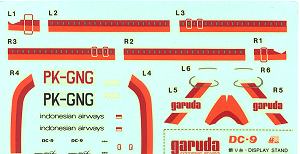
|
KIT: |
Hasegawa 1/200 DC-9-30 |
|
KIT # |
La 3 |
|
PRICE: |
$8.00 (?) |
|
DECALS: |
Garuda Indonesian Airways |
|
REVIEW & |
|
|
NOTES: |
|

|
HISTORY |
One of the last of the Douglas designed airliners was the medium haul DC-9. Designed in several fuselage lengths from the short -10 to the super stretched -80, the most pleasing of them all is the -30 version. Of course, I could be biased as I worked on Navy C-9Bs back in the mid 1970s and those are of the same variant! Once Douglas was bought by McDonnell, the aircraft became the MD-80 and even more improvements in engines and interiors came with it. Now that McDonnell/Douglas has been bought by Boeing, the aircraft lives on as the Boeing 717. Sure, they say it is an all new aircraft, but you can still see the DC-9 design and legacy in this 'new' Boeing airliner!
|
THE KIT |
 Back in the late
1980s, Hasegawa decided to get into the airliner kit market. Now the main scale
for airliners until that time was 1/144. Hasegawa realized that most of its
market was at home, and Japanese houses don't have lots of space in them. To do
a full line of kits, would not only mean having some pretty big models (a 1/144
B.747 isn't by any means small), but having to compete with existing kits from
Revell and Airfix.
Back in the late
1980s, Hasegawa decided to get into the airliner kit market. Now the main scale
for airliners until that time was 1/144. Hasegawa realized that most of its
market was at home, and Japanese houses don't have lots of space in them. To do
a full line of kits, would not only mean having some pretty big models (a 1/144
B.747 isn't by any means small), but having to compete with existing kits from
Revell and Airfix.
What they did was to release their airliners in 1/200 scale. This accomplished several goals. A full range of kits could be done without having to compete with existing models. The kits were small enough to be manageable, but not so small as to be unworkable. This also meant that they would fit on shelves in smaller homes.
The first kits issued were the DC-9, DC-10 B.727-200, B.737-200, B.747, L.1011, and A.300. Since then a number of other airliners have been added including B.767, B.777, and MD-11. Most of the kits carry liveries from Japanese or Asian airlines as befits the Far Eastern market. However, there are lots of aftermarket decal sheets for just about any airline you may wish to model.
 The kits themselves
are all pretty simple. The DC-9 consists of 24 parts and a stand. Most of those
parts are the individual wheels for the landing gear. The fuselage has holes for
the windows, though many airliner enthusiasts would rather there be decals for
the windows instead. There are no separate gear doors, these being molded on the
fuselage or landing gear. The only transparency is for the windscreen. You are
given plastic bulkheads for the nose to provide nose weight. The kit can be
displayed gear up, but for that you will have to delete the landing gear, fill
the gear wells, smooth and scribe on door markings. There is, of course, no
interior of any kind.
The kits themselves
are all pretty simple. The DC-9 consists of 24 parts and a stand. Most of those
parts are the individual wheels for the landing gear. The fuselage has holes for
the windows, though many airliner enthusiasts would rather there be decals for
the windows instead. There are no separate gear doors, these being molded on the
fuselage or landing gear. The only transparency is for the windscreen. You are
given plastic bulkheads for the nose to provide nose weight. The kit can be
displayed gear up, but for that you will have to delete the landing gear, fill
the gear wells, smooth and scribe on door markings. There is, of course, no
interior of any kind.
The decals are very colorful and go on well (I have built a few of these kits before). They are also a bit thick, which means they can stand quite a bit of handling as you try to get them to line up on the fuselage. The downside is on the older kits (like this one), the decals yellow rather quickly so if you don't have fresh ones, aftermarket replacements are needed. The instructions are very simple as befits a kit with so few extra parts and options.
If you have any real interest in airliners, are not stuck in one scale, and want something that builds pretty quickly, these are the kits for you. The ease of construction and toughness of the decals makes them very good kits for the beginner.
|
CONSTRUCTION |
|
PAINT & DECALS |
|
CONSTRUCTION |
|
CONCLUSIONS |
|
REFERENCES |
Review copy courtesy of me and my wallet!
If you would like your product reviewed fairly and quickly by a site that has over 900 visits a day, please contact me or see other details in the Note to Contributors.